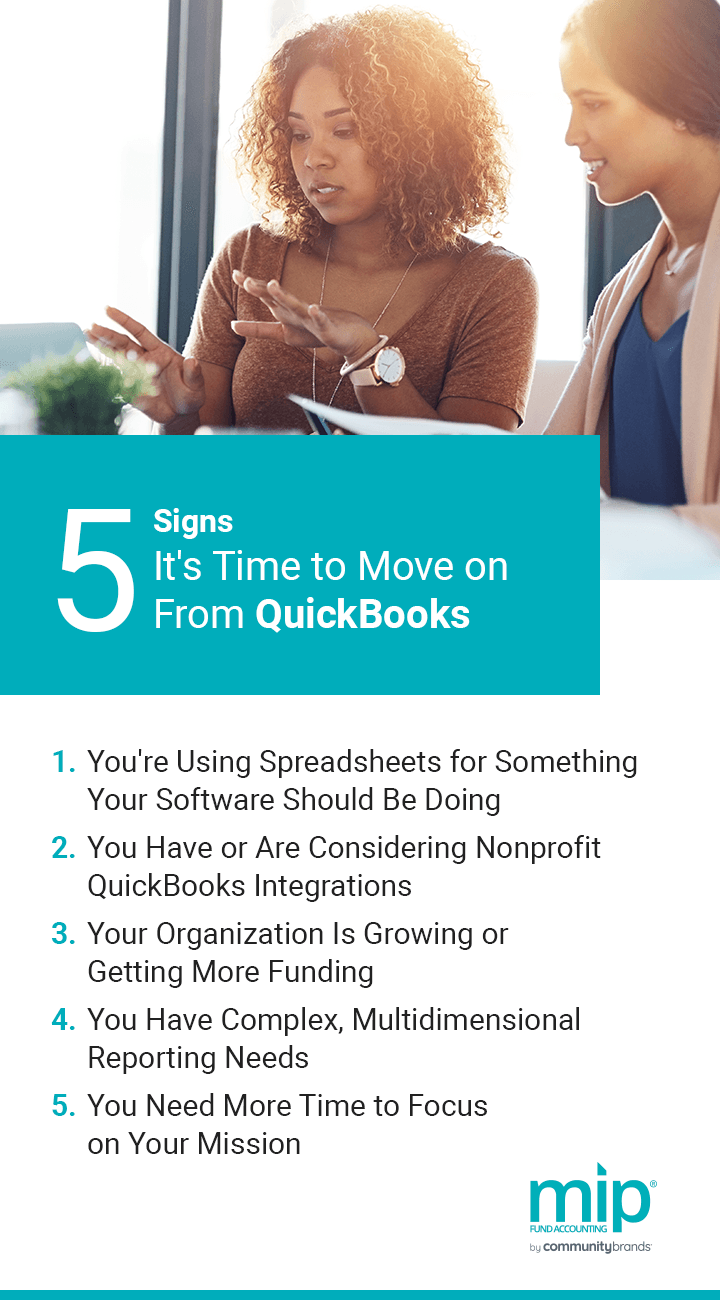Whether we’re in times of economic growth or times of uncertainty, nonprofits need best-in-class tools to ensure their financial health and stability for the years to come. While many nonprofits may start off with simpler accounting tools or off-the-shelf commercial accounting software, such as QuickBooks, over time, most realize generic software is no longer able to meet their organization’s financial management needs.
As nonprofits grow and gain multiple funding sources, along with special tracking and reporting requirements, they need a more robust accounting solution that specifically facilitates storing, organizing and reporting on data from multiple revenue sources. A true fund accounting software systemcan provide an organization with an end-to-end financial solution and the ability to centralize critical finance tools, automate processes and tailor these to specific needs and requirements.
The absence of these capabilities and core functionality introduces risk to an organization and unnecessary strain on time and resources that only grows with time. This is especially true when it’s time to compile reports at the end of a financial year or prepare for an internal or external audit.
Fund accounting software can:
- Reduce reporting time from hours to minutes.
- Help you efficiently track funds.
- Effectively meet compliance and reporting requirements.
- Provide you the real-time insights, reporting and financial transparency you need to make critical business decisions.
Maybe your organization is experiencing growth or considering expanding your mission and services in the coming years. Or, perhaps you have simply recognized you’ve outgrown your current accounting solution – and just can’t take the frustrations and manual workarounds any longer. It’s never too early or too late to upgrade to a true nonprofit accounting solution.
Our buyer’s guide will provide you with critical considerations in evaluating your organization’s next accounting system and help you understand how to choose the right fund accounting solution for your nonprofit. With this helpful resource, you can start to plan strategically and focus on what matters most.
More Funding Means More to Keep Track Of
Has your nonprofit been experiencing a lot of growth, or have you started adding funding through new grants? It’s great, right? You’re able to support your community better and have more resources to help fulfill your mission. Still, with more funding comes a few more complexities.
As a nonprofit that accepts donations from the public, your organization must show greater accountability. The government and your donors need to know that donor dollars go toward the charitable causes you say they do. As your nonprofit grows, certain funds may get earmarked for different purposes. You may win a grant for specific programming or receive a private donation that the donor specifies must go toward a particular purpose.
Suddenly, you have several funding sources and differing parameters for how you can legally spend that money. Lumping all your income together the way a for-profit business does is out of the question. Once you have multiple grants or several pools of in-kind donations, you must manage each separately, in the same way a business owner would have to handle multiple companies. Each source of funding will have its own budget and financial statements. Managing funds this way is called fund accounting.
Many smaller nonprofits go for the fast and affordable off-the-shelf financial solutions, and when you’re just starting out, that strategy probably works just fine. However, when a nonprofit grows large enough to have multiple funding sources, commercial financial software just can’t handle it anymore, given nonprofits’ special tracking and reporting needs.
Many nonprofits try to make do, adding spreadsheets or trying to customize or add new features to their software. All of these approaches serve as Band-Aids, at best! When do you know you’ve reached the point of no return? Ask yourself:
- Am I able to create reports for varying fiscal years?
- Can I track all inflows and outflows by fund?
- Can I manage restrictions based on my funding sources?
- Does my current financial solution incorporate nonprofit-specific accounting rules?
- Can I easily tailor reports for each funding source?
- Do I have a complete audit trail?
If you answered “no” to any of these questions, your software is holding you back. Many of these are mandatory requirements for nonprofit accounting, and you could face consequences, including loss of funding or tax-exempt status. While moving all of your data and implementing a new system can be a challenge, it’ll be worth it. You’ll cut out the manual spreadsheets and have the proper reporting at the ready for every audit.
How QuickBooks Attempts to Handle Fund Accounting
QuickBooks was built for commercial businesses, first and foremost. Unfortunately, QuickBooks doesn’t have a turnkey fund accounting software. To handle this accounting complexity, you’ll have to configure many different settings in either QuickBooks Online or QuickBooks Desktop. Many nonprofits find they need third-party integrations to handle fund accounting the right way. However, it is possible to use QuickBooks for nonprofit fund accounting. Here’s how:
1. Turning on Class Tracking
QuickBooks class tracking is the feature that lets you track different funding sources. Organizations can use class tracking for many purposes, and nonprofits specifically use it for fund accounting. QuickBooks also has features called “Accounts” and “Jobs,” which you can use to track your financials on several data points at once. However, the jobs data point isn’t available on all QuickBooks reports. If you need to track your accounts on more than two dimensions, we recommend a purpose-built nonprofit accounting software.
If you just have a few simple funds to keep track of, you can do it through QuickBooks class tracking. To turn this setting on, you’ll go to “Settings” and then “Account and Settings.” Under “Advanced,” you can create editable fields in the “Categories” section. As you’re doing this, click the checkbox labeled “Track classes.” Hit “Save” and then “Done.” After turning on class tracking, you’ll see an editable class field on all your accounting forms, allowing you to select a specific fund for every transaction.
2. Setting up a Class for Each Fund
Once class tracking is on, you’ll use separate classes to track each fund. Some nonprofits separate their financials into three classes — unrestricted, temporarily restricted and permanently restricted.
Unrestricted funds, a favorite for most nonprofits, can be used however the organization sees fit. They’re not earmarked for a particular program or purchase. Most in-kind donations are unrestricted funds unless a donor specifies a purpose.
Next, temporarily restricted funds are designated for a specific purpose and must be used by a set date. Most grants are temporarily restricted funds, alongside any donation where the donor specifies a deadline. Next, permanently restricted funds represent gifts that are permanently held, such as real estate.
Within the restricted categories in QuickBooks, you can create subclasses for the funds reserved for particular purposes. For example, you could create a subclass for a specific grant name or the funds associated with a special program.
To set up classes for your funds, select “Settings” first, and under “Lists,” select “All Lists.” Within the “Lists” screen, choose “Classes” and hit “Next.” On the “Class” dialog page, you’ll see fields labeled “Name.” Enter the name of each fund in this field, then hit “Save.”
3. Tracking Multiple Funds With Bank Sub-Accounts
If your nonprofit has multiple funds, you can record them all to a single bank account in your chart of accounts. Then, you can use sub-accounts to track income and expenses for individual funds.
To do this in QuickBooks, find the “Chart of Accounts” within “Settings.” Then, select “New.” This will open the “Account” dialog. On the “Account type” drop-down menu, select “Bank.” From the “Detail Type” drop-down list, choose “Checking.” Then, enter the fund’s name in the “Name” field and check the box that says “Is sub-account.” Then, from the “Enter parent account” drop-down list, find the bank account you want the sub-account associated with. Hit “Save and Close.”
4. Running a Profit and Loss Report
Once you’ve entered all your classes and assigned all your transactions to a class, you can run a profit and loss report that breaks down by class.
From “Reports,” you’ll find a selection that reads “Profit and Loss by Class.” When you pull this report, it will reflect all transactions from the current fiscal year. To review data on the entire life of the fund to date, choose “All Dates” from the “Report period” drop-down menu. Finally, hit “Run Report.”
But Is QuickBooks Really Good for Nonprofits?
For the right customers, QuickBooks is a fantastic tool. Small and medium businesses love it for its user-friendly interface and simplified processes. It follows small business accounting rules by design and supports the simple purchasing workflows these organizations require. It also has simple reporting features that satisfy most business users’ needs. These capabilities have made this accounting tool the most well-known by far among small and medium-sized enterprise owners, with 70.2% claiming familiarity with it.
The operative word here is “business.” QuickBooks has practically cornered the small business market by catering to the specific needs of the busy small business owner. The software is relatively simple to use for uncomplicated accounting scenarios and commercial businesses that don’t need to show enhanced accountability over their finances. The features that make QuickBooks great for small businesses make it less well adapted for fund accounting and the typical needs of a nonprofit organization.
For example, the class tracking features some nonprofits use for fund accounting are primarily for for-profit businesses. They work best to handle separate accounting records by department, branch or product line, rather than funding sources. Classes are less well suited to help organizations create separate financial statements for each fund and provide a detailed audit trail for grant providers, other donors and government entities.
QuickBooks has some weaknesses when it comes to nonprofit accounting, such as:
Simplistic Chart of Accounts
To get a chart of accounts customized for the nonprofit sector, customers must invest in the QuickBooks Enterprise Nonprofit desktop solution. The one available at the lower-priced versions of QuickBooks doesn’t offer the flexibility most nonprofits need. Without the enterprise version, the class tracking system is the only way to add additional flexibility to the chart of accounts. Other than that, nonprofits can access a basic ledger for assets, liabilities and equity. It’s much more challenging to get into granular detail on the transactions involved in individual funds.
Inadequate Budgeting and Reporting Options
While QuickBooks offers some limited budgeting capabilities, most nonprofits still handle their budget in spreadsheets. That’s because they must account for funding sources in their budgets and create individual budgets for different grants and funding sources.
Likewise, most QuickBooks reporting won’t go into enough detail to create reports for individual funding sources. Since many of your grant providers and more prominent donors will set unique reporting requirements, you may be handling this additional complexity in a spreadsheet, too. Purpose-built nonprofit accounting software from MIP offers multidimensional reporting, with the ability to forecast financials using scenario analysis. It also allows you to build complex budgets right within the software.
5 Signs It’s Time to Move on From QuickBooks
For most nonprofits, QuickBooks is fine as you’re starting out. Once you start growing, it becomes less and less useful. Your organization may have outgrown QuickBooks if:
1. You’re Using Spreadsheets for Something Your Software Should Be Doing
How many spreadsheets are you using outside of QuickBooks? Many nonprofits have quite a few. Remember — accounting software is supposed to replace spreadsheets and manual processes. If your growth is causing you to export data as a spreadsheet so you can slice and dice it how you want, it’s time for an upgrade.
While nonprofit accounting is more complex than small business accounting, the right software can handle it easily. It just follows a different set of rules. When a software is built from scratch following Financial Accounting Standard Board guidelines alongside nonprofit accounting rules and practices, you can do everything you need and more from right within the software, just as it should be.
2. You Have or Are Considering Nonprofit QuickBooks Integrations
Because QuickBooks doesn’t have all the features nonprofits need, many third-party developers have created solutions to fill in the gaps. Many of these integrations don’t work as intended or create more confusion than clarity. Most nonprofits are better off choosing a system that has all the necessary features as a standard offering. You’ll spend less time researching potential solutions, configuring add-on software and establishing manual workarounds.
3. Your Organization Is Growing or Getting More Funding
With every source of funding comes a new entity to report financials to. It’s simple enough to handle a few grants in a spreadsheet. However, once you’re working with larger sums of money from more grant providers, the process becomes complicated and time-consuming.
4. You Have Complex, Multidimensional Reporting Needs
Nonprofits need to create custom reports for every funder backing them. That requires more than generating reports separated by class. They often need to track expenditures and income for several different programs, split between several funding sources. They also need to dive into more depth with advanced analytics and reports tracking several dimensions to keep their funders satisfied.
In QuickBooks, the Balance Sheet by Class is a separate report from the Profits and Loss Report by Class. While QuickBooks recommends the Balance Sheet by Class report for any organization that handles fund accounting, it is only available to QuickBooks Premier and QuickBooks Enterprise users. If you don’t already have this version of the software, you could spend significant funds on a product that’s still not designed for your accounting needs or your organization. You’ll still be using manual workarounds and spreadsheets.
Nonprofits need to show accountability in their spending, and that includes their business software. It’s a much wiser and easier-to-justify investment to choose an accounting software where the advanced, multidimensional reports nonprofits need come standard.
5. You Need More Time to Focus on Your Mission
Nonprofits can do more with less. They do incredible work on impressive timelines with a less-than-ideal budget and a lean staff. Your team loves what they do and dedicates their time out of their passion for your mission.
Wrestling with your accounting software is likely a time suck. You might be entering the same data more than once, pulling custom reports via spreadsheets or building your own audit trail by hand. Plus, if you ever need technical support, you’ll spend even more time waiting on hold with an answering service. All that time gives your team less time and energy to dedicate to what they do best — helping others.
Our research shows you could earn back 96 hours per year by using the right accounting tools. Using a software built from the ground up for nonprofits means you can automate more manual tasks. It’ll automatically follow nonprofit accounting rules, so you can do more in just a few clicks. You can pull the complex reports you need in minutes rather than hours. And when you choose MIP for fund accounting, you can always get to a live person when you have questions.
Request a Demo of MIP Fund Accounting
When it’s time to leave QuickBooks behind and move to purpose-built fund accounting software for nonprofits and associations, consider MIP Fund Accounting, your comprehensive nonprofit accounting solution. We built our software with all the advanced reporting and tracking tools nonprofits need, making it easy to follow nonprofit financial practices.
Find out if MIP is right for you — sign up for a demo today.







